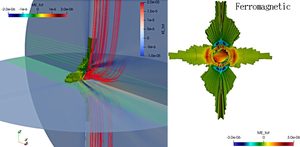
The first confirmed extrasolar planets were found by Alex Wolszczan and Dale A. Frail (1992). They detected the planets by finding the slight variations in otherwise highly regular timing of the pulses, caused by the planets orbiting a millisecond pulsar PSR B1257+12, some 2300 light years from us. The timing method remained the only way of registering such planets. Any other information about the millisecond pulsar wind or planets remains unknown until we do not find a way to measure electromagnetic signal from such objects. At such a distance, it is usually considered to be a task for the future generations of radio telescopes. In a recent work, "Auroras on Planets around Pulsars" (2023), by Ruchi Mishra and Miljenko Čemeljić from the Copernicus Astronomical Center in Warsaw, conducted in CAMK Warsaw with international collaborators and published in The Astrophysical Journal Letters, authors present a challenge to the current facilities, to measure the radio emission from the aurora around the planets around pulsars, created by the magnetospheric interaction of a millisecond pulsar and a planet. Since neutron stars have much larger magnetic fields than the other stars, the radio emission from such planets should be stronger. Using the special-relativistic module in the PLUTO code, authors perform full 3D ideal magnetohydrodynamic simulations of pulsar–planet magnetospheric interaction and estimate the radio emission from such systems. The outcome from the simulations, shown in the Figure, shows that the resulting radio emission from aurora on such pulsar planets could be observable with the current radio telescopes. The predicted parameters for such a detection are listed in the paper. If successful, such a detection would be the first radio detection of an extrasolar planet. There are other tentative candidates, but we are still waiting for a confirmed case. In addition to obtaining additional information on planets in such extreme conditions, a bonus result would be a direct probe into the millisecond pulsar wind.
Figure: The divergence of the total Poynting flux ME and kinetic energy flux KE for the planet with a ferromagnetic surface are shown in the left panel, with the color graded isocontours and background showing the mass density ρ. The red lines depict the magnetic field lines, and green lines show the velocity streamlines of pulsar wind. In the right panel is shown ME in the zoomed-in image of the radiative pattern. Locations with the maximum radiated power are located in the middle of the planet dayside and in the base of the Alfvén wings.
Text: Miljenko Čemeljić






